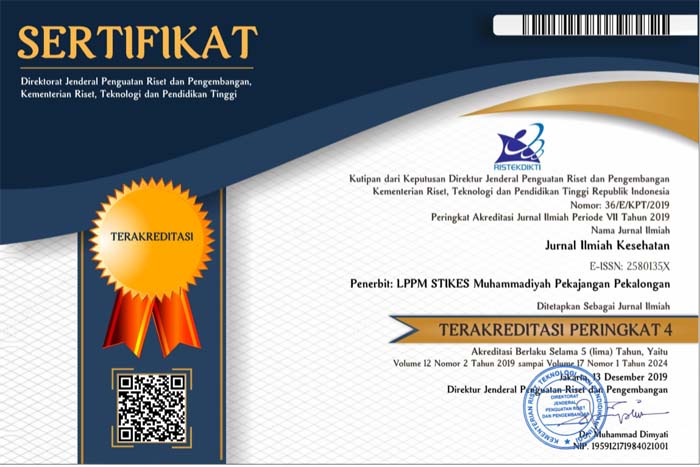Efek Posisi Orthopneic Terhadap Fungsi Pernafasan: Systematic Review
DOI:
https://doi.org/10.48144/jiks.v13i2.252Abstract
Gangguan fungsi pernafasan merupakan masalah yang sering muncul pada pasien Penyakit Paru Obstruktif Kronis (PPOK). Posisi orthopneic adalah intervensi nonfarmakologi yang dapat diberikan pada pasien PPOK. Akan tetapi, sejauh ini belum cukup bukti tentang pengaruh posisi orthopneic terhadap fungsi pernafasan karena outcome yang berbeda-beda. penelitian ini bertujuan untuk mengetahui pengaruh posisi orthopneic terhadap fungsi pernafasan pada pasien PPOK. Kriteria inklusi pada review ini adalah: studi eksperimental, pasien dewasa dengan PPOK derajat sedang sampai berat. Adapun keriteria ekslusi adalah pasien PPOK dengan ventilator dan penelitian pada orang sehat. Pencarian literatur menggunakan sistem database EBSCO, SCOPUS, Pubmed, SinceDirect dan Google Scholar dari tahun 2008 sampai 2019, berbahasa Inggris dan Indonesia. Hasil analisis 8 artikel didapatkan bahwa posisi orthopnneic efektif dalam meringankan atau menurunkan sensasi dispnea pada pasien PPOK dengan rata-rata penurunan (mean pre= 21,87 dan mean post= 20,80), memaksimalkan fungsi otot aksesoris pernafasan (Sternocleidomastoideus dan Scalenus) (SCM: USit= 4.80 dan SitAs= 7,92) dan (sc : USit= 9.44 dan SitAs= 15,29), meningkatkan volume tidal (NP = 0,7+0,2) dan (WAHS =0,8+0,3)(Kim et al., 2012) dan meningkatkan nilai APE 27,48% + 14,04%(Ritianingsih et al., 2011). meningatkan nilai maksimal inspirasi (64 ± 22 cmH2O with arm bracing versus 54 ± 24 cmH2O without arm bracing; P= 0.0001). dan maksimal ekspirasi (104 ± 37 cmH2O with arm bracing versus 92 ± 37 cmH2O without arm bracing; p = 0.0001). Gangguan utama pada pasien PPOK adalah proses ekspirasi yang memanjang akibat adanya obstruksi. Posisi orthopneic memaksimalkan fungsi otot aksesoris pernafasan, sehingga proses inspirasi dan ekspirasi menjadi maksimal.
Kata kunci: Fungsi Pernafasan, Posisi Orthopneic, PPOK.
Orthopneic Position Effects on Respiratory Function: Systematic Review
Abstract. Impaired respiratory function is a problem that often arises in patients with Chronic Obstructive Pulmonary Disease (COPD). The orthopneic position is a non-pharmacological intervention that can be given to COPD patients. However, so far there is not enough evidence about the effect of orthopneic position on respiratory function due to different outcomes. This study aims to determine the effect of orthopneic position on respiratory function in COPD patients. The inclusion criteria for this review are: experimental studies, adult patients with moderate to severe COPD. The exclusion criteria are COPD patients with ventilators and studies in healthy people. A literature search using the EBSCO, SCOPUS, Pubmed, ScienceDirect, and Google Scholar database systems from 2008 to 2019, in English and Indonesian. The results of the analysis of 8 articles found that the orthopneic position is effective in relieving or decreasing dyspnea sensation in COPD patients with a mean decrease (mean pre = 21.87 and mean post = 20.80), maximizing the function of respiratory accessory muscles (Sternocleidomastoideus and Scalenus) ( SCM: USit = 4.80 and SitAs = 7.92) and (sc: USit = 9.44 and SitAs = 15.29), increasing the tidal volume (NP = 0.7 + 0.2) and (WAHS = 0.8 + 0 , 3) 7 and increase the APE value 27.48% + 14.04% 5. increase the maximum inspiration value (64 ± 22 cmH2O with arm bracing versus 54 ± 24 cmH2O without arm bracing; P = 0.0001). and maximal expiration (104 ± 37 cmH2O with arm bracing versus 92 ± 37 cmH2O without arm bracing; p = 0.0001). The main disorder in COPD patients is the process of expiration which is prolonged due to obstruction. The orthopneic position maximizes the function of respiratory accessory muscles so that the process of inspiration and expiration is maximized.
Keywords: COPD, Orthopneic Position, Respiratory Function.












